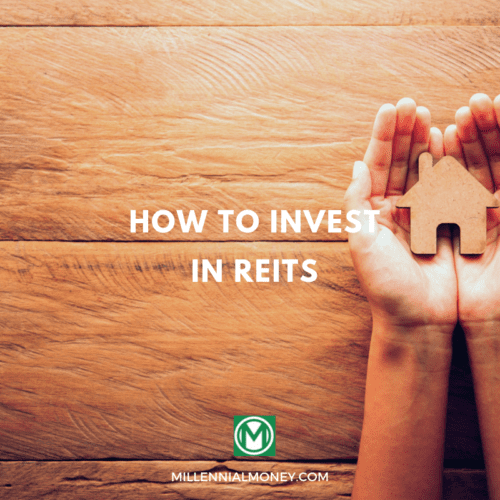If you have the money and want to invest $30k, you’re wise for considering it. But jumping in too fast could force you to make the wrong decisions, leaving you with a loss.
I’ve outlined the top nine ways how to invest $30k safely so you can increase your funds and reach your financial goals.
9 Best Ways to Invest $30k
Here are nine great ways to invest $30k wisely:
- Real Estate Investments
- Index Fund Investments
- Stock and ETF Investments
- REIT Investments
- Mutual Fund Investments
- Alternative Asset Investments
- A Fixed-Income Investment
- Robo Advisor Investments
- College Education
1. Real Estate Investments
Real estate can be a great hedge against inflation and offers many benefits for real estate investors. Of course, $30k won’t buy you a house unless you use it as a down payment, but there are many alternatives to invest in real estate.
Real Estate Partnerships
Joining forces with another real estate investor can help you invest in real estate when you don’t have enough to buy it yourself. For regular monthly income, consider investing in rental real estate, such as multi-family properties.
Partner with someone you know you can trust and work well with because you’ll be making important investing decisions together and relying on one another to manage the properties.
Crowdfunding
If you prefer a more indirect way to invest in real estate, consider crowdfunding. Of course, this method requires investing with many other investors, but not directly.
You pool your money with several (or more) real estate investors to fund rental real estate purchases. The crowdfunding platform does all the work; you choose the investments you want to put your money into and collect profits from rental income and capital appreciation.
Many crowdfunding platforms, like Fundrise, allow investments as low as $10, while others, like RealtyMogul, require higher minimum investments of $5,000. The key is diversifying your funds across different real estate investments for maximum profits.
I’ve been investing with Fundrise since 2017. Disclosure: when you sign up with my link, I earn a commission. All opinions are my own.
House Hacking
House hacking can work in a couple of ways. The most common is buying a multi-family property with a primary residence mortgage by living in one of the units. Then, you rent the remaining units out and collect rent, using the funds to pay the mortgage and collect profits.
If you don’t want to invest in a multi-family unit, you can convert a part of your home to a separate living residence and rent it out full-time.
The key is that you have a primary residence mortgage with lower interest rates than investment mortgages require, saving you money and allowing you to have higher earnings.
Home Renovations/Flipping
If you don’t see yourself as a landlord but want to invest in real estate, consider buying undervalued properties and renovating them. Then, you can flip them for a profit by selling them for more than you paid (including the renovation costs).
This takes some practice and knowledge of the area to get the best deal on an undervalued property. It also helps if you have a network of contractors to control your costs and work with reputable people who will do the job quickly.
Most house flippers buy and flip a house within six months for maximum profits.
2. Index Fund Investments
Index funds are diversified assets that mimic an index, typically the S&P 500. These funds usually have low costs and are passively managed, so you don’t have to do anything once you invest your funds.
Most index funds outperform actively managed funds, especially when you keep them long-term.
3. Stock and ETF Investments
Stocks and ETF investments are the most common way to invest $30k. You have thousands of options and can invest in various industries and even stocks. In addition, most brokers offer commission-free trades for both stocks and ETFs. A combination of both is a great way to diversify your portfolio.
If you want to invest aggressively, you can consider growth stocks, and if you prefer a more passive strategy, ETFs may be a better option.
INVESTMENT AND INSURANCE PRODUCTS ARE: NOT A DEPOSIT • NOT FDIC INSURED • NO BANK GUARANTEE • MAY LOSE VALUE4. REIT Investments
REIT investments are investments in a real estate company that buys commercial investment properties. They use the funds from investors to buy and manage properties. REITs must pay back at least 90% of their profits to shareholders.
REIT investing can be a great indirect way to invest in real estate. You don’t have to worry about managing properties yourself, and you’ll likely invest in properties you couldn’t afford, opening up the possibility for even greater profits.
5. Mutual Fund Investments
Mutual funds are another way to diversify your funds with little effort. Mutual funds are a lot like index funds; however, they are actively managed, so they have higher fees. On the other hand, mutual funds can be less risky than stock investments because they are diversified and managed for you.
When looking for mutual funds, pay close attention to the load fees and other costs. Many brokers are moving to low-cost mutual funds but reserve them to only a handful of their mutual fund selections.
6. Alternative Asset Investments
If you want to diversify how you invest $30k, consider including alternative investments in your portfolio.
The most common alternative investment is cryptocurrency, but there are other options, too, including:
- Art
- Farmland
- Wine
- Small business start-ups
7. A Fixed-Income Investment
Fixed-income investments are a great conservative addition to any portfolio. While the rate of return is usually much lower on fixed-income assets, their stability can be worth it, especially if you have aggressive investments in your portfolio.
Fixed-income assets work best for short-term goals or for anyone needing to add a conservative asset to their portfolio. Common fixed-income assets include bonds, CDs, and high-yield savings accounts.
8. Robo Advisor Investments
Robo advisors are a great way to take advantage of passive investing. You answer questions about your financial goals, risk tolerance, and timeline, and the robo-advisor determines the best way to invest your funds.
Your only job is to fund your account and set up regular contributions. Then, the robo-advisor will rebalance your portfolio as you deposit and withdraw funds and when the market changes. Many robo-advisors are free, while others charge a small percentage of your assets under management annually.
9. College Education
Consider investing some of your $30k in their college education if you have kids. A 529 savings plan may offer tax advantages now, allowing your funds to grow tax-deferred.
The withdrawals are tax-free if you use the funds for qualified educational expenses. If your child doesn’t go to college, you can roll the funds over to a retirement account for your child or transfer it to another child.
Considerations Before You Invest $30k
Having $30k sitting idle isn’t ideal, but before you invest your money, consider these factors. Having a plan and ensuring your needs are cared for first is essential so you can leave your investments to grow. The longer you can leave your money in an investment, the more time you have for compound earnings and to reach your financial goals.
Determine Investment Timeframe
Your timeframe is important in determining how and when you should invest. Consider two timelines – short-term and long-term.
Short-term investments have less time to grow and less time to compensate for losses. So you’ll need to be more cautious when investing for the short term. If you invest too aggressively, you risk losing your principal rather than making your money grow.
Long-term investments, however, provide more flexibility. You have more time for your earnings to compound and time to make up for any downturns. As a result, there’s less risk of losing your principal and a higher chance of making more money.
Examples of short-term investments include saving for a down payment on a house or buying a car. Long-term investments usually involve retirement or anything you’ll achieve in 5+ years, such as saving for a college education.
Analyze Your Risk Tolerance
Some people are cut out to be thrill-seekers. They love roller coasters and haunted houses, and likely gambling. Taking chances is a thrill, and they likely have higher risk tolerance. As a result, they can handle the market’s ups and downs without losing sleep.
Other investors can’t stomach the ups and downs and need more conservative investments to sleep at night.
Of course, your timeline plays a role too. The sooner you must achieve your goals, the lower your risk tolerance.
Build Your Emergency Fund
Having $30k is great, but you could be in a financial bind if you tie it up in long-term investments and experience a financial emergency.
Before you invest $30k, ensure you have a solid emergency fund. At a minimum, save six months of expenses, but given the nature of the economy over the last couple of years, setting aside a year’s worth of expenses isn’t a bad idea.
Keep your money in an online high-yield savings account separate from your checking account, so you aren’t tempted to spend the funds. If you use funds for an emergency, be sure to replenish them.
Practice Strong Savings Habits
Before investing your $30k, ensure you understand (and can implement) how to save. If you spend too much, you could put yourself in a financial bind if your extra money is tied up in long-term investments.
Create a budget and make sure you can stick to it before investing your funds. If you’re unsure about changing your spending habits, consider keeping some funds in a liquid account that doesn’t incur penalties if you withdraw funds.
Consider Your Current Life Stage
Determine where you’re at in life. For example, are you newly married and planning to grow your family, or are you well-established with kids about to move out, and you can focus on yourself?
Also, consider your near-future goals or plans. For example, are you moving for work or staying put? Will you downsize soon or buy a bigger house to accommodate your large family?
Knowing where you stand will help you determine your risk tolerance, timeline, and how you should invest $30k.
Take Care of Outstanding Debts First
Any high-interest debt you carry, take care of first. It doesn’t matter how good you think you are at investing or what return you can get; you’ll never outpace credit card and other high-interest loan debt.
Pay off the debt first and then invest. Believe it or not, paying off debt gives you a great return on your investment because you’re saving the 10 to 30% interest you’re paying on these debts.
Ensure You Have a Retirement Plan
Retirement savings should be a top priority for everyone, regardless of age. Yes, even if you’re in your 20s, retirement should be a priority. The earlier you save your funds, the more time they have to grow and compound.
There are many opportunities to save for retirement, and I suggest you maximize all opportunities.
Employer-Sponsored Retirement
An employer-sponsored retirement account is a 401K or 403b. These accounts are held by your employer, who may offer an employer match. In 2023, you can contribute up to $66,000 of your income to your 401K.
You can set aside some of your income each payday for retirement, and most plans offer the option for a traditional or Roth account.
A traditional account provides tax advantages when you contribute. Your contributions are pre-tax, and your earnings grow tax-deferred. When you withdraw the funds in retirement, you pay taxes at your current tax rate.
A Roth account requires after-tax contributions, but all money (contributions and earnings) grows tax-free. If you wait until at least 59 ½ to withdraw funds, you’ll pay no taxes on any funds withdrawn.
The most important part of employer-sponsored plans is the employer match. Many employers will match a percentage of your salary and contribute to your retirement account if you do. So don’t miss this opportunity for free money.
Individual Retirement
If you’re employed, you may also open an IRA. These accounts aren’t sponsored by anyone and have much lower annual contribution limits of $6,500.
Like 401K accounts, you can choose a traditional or Roth IRA, which determines how the contributions affect your tax liabilities.
If you don’t work but are married to a working spouse, you can still open an IRA to save for retirement.
Open a Health Savings Account (HSA)
A Health Savings Account is a savings account for medical expenses. You can contribute to it pre-tax, and if you use the funds for eligible medical expenses, your withdrawals are tax-free.
The nice thing about HSA funds is they roll over each year. So you can continue saving the funds for a time when you may not have as much for medical bills or your bills will be higher, especially in retirement.
You can think of HSAs as a backup retirement account because you can use the funds to cover eligible medical expenses and save your retirement funds for other costs.
Investments You Want to Avoid
The above investments are all great ways to invest 30k, but there are certain investments you should avoid at all costs, no matter how good they sound.
- Penny Stocks: Penny stocks are enticing because of their low buy-in but aren’t worth it. You don’t get the same financial information you get with traditional stocks, so you don’t know what you’re investing in or if it’s a good risk. Most penny stocks are investments in small companies or companies in trouble and trying to grow more capital.
- Pyramid Schemes: Pyramid schemes are business models that encourage you to bring people in underneath you and profit from what they bring in for the company. These schemes rarely make sense, though. How can everyone at the top benefit from the people underneath them? They are typically a scam and aren’t worth your money.
- Gambling: Gambling is based on luck, not strategy. You don’t have a chance to make your money back as you do with stocks that plummet, and gambling can be addicting. Gambling rarely works the way the gambler hopes and isn’t worth the high risk.
How to Pick Your Investment Strategy
Everyone has different investment strategies because they have different financial situations and goals. Here’s what to consider when choosing your investment strategy.
1. Be Mindful of Extra and Hidden Fees
Always look at the disclosed and hidden fees. If you don’t understand an investment’s cost, your profits could be much lower than anticipated because of the fees. Look for asset under management fees, advisor fees, paper statement fees, withdrawal fees, and account transfer fees, among others.
2. Consider Your Passive vs. Active Options
Determine if you want a passive or active investment strategy. If you choose active, you’re responsible for managing your investments, including deciding when to buy and sell.
Passive investing means you don’t have to spend much time researching, tracking the market, and deciding when to buy or sell investments.
Most investors choose a healthy mix of both strategies to diversify their portfolios.
3. Keep Your Investing Simple
Keep it simple, and don’t overcomplicate things. Investing in complicated assets or constantly buying and selling investments doesn’t increase your chance of higher returns.
Most active investors don’t beat the market, so it’s not worth the time, effort, or risk to complicate things.
4. Diversifying Your Investment Portfolio
No matter your investment strategy, always diversify. This ensures you won’t have a total loss if the market tanks. Diversifying means you put money in different sectors and types of investments. Typically when one sector performs poorly, others do the opposite, so diversifying can benefit you.
Helpful Investing Tips
Before investing $30k, consider these helpful tips.
- Create a plan: Don’t invest blindly. Create a plan considering your goals, strategies, and risk tolerance. This helps you make more informed decisions and avoids emotional decisions while investing.
- Be mindful of tax liabilities: Different investments affect taxes in different ways. Try maximizing your tax efficiency to minimize the taxes you owe. For example, short-term capital gains are taxed higher than long-term capital gains, so create strategies to offset your tax liabilities and increase your profits.
- Don’t follow everyone else: Create your own investment strategies based on your goals and no one else’s. Don’t follow hot tips unless you’ve done your research and know it’s a suitable option for you.
- Invest regularly: Make contributions regularly to grow your portfolio continually. This way, you’re not timing the market and investing at different times, some good and some bad. This is called dollar-cost averaging and gives you the best of both worlds, so you aren’t waiting for the ‘perfect time’ to invest and miss opportunities.
Frequently Asked Questions
Investing 30k is important because letting it sit in a savings account won’t make it grow to reach your financial goals. Here are some common questions people have about investing their money.
How do I know if I am ready to start investing?
You’re ready to start investing when you’ve established a good financial foundation. For example, you have an emergency fund, you’re out of high-interest debt, and you’ve maximized your annual retirement savings.
What is the least hands-on investing strategy?
Robo-advisors are the most hands-off strategy. Your only job is to fund your account and answer questions about what you want from your investments. Many robo-advisors are free and manage your funds for you so that you can invest without stress.
What is the fastest way to double my money?
Investing isn’t short-term or a get-rich-quick scheme. While you can double your money over time, it won’t happen overnight. So choose investments that meet your risk tolerance and diversify your portfolio to ensure you reach your financial goals.
How much should I have in savings before investing $30k or more?
It’s best to have six to twelve months of expenses saved before investing. This way, you can handle any financial emergencies that come your way without prematurely withdrawing funds from your investments.
How Should You Invest $30k?
Investing $30k is a journey you should take seriously. There aren’t any rules regarding how to do it, but you must consider your goals, timeline, and risk tolerance.
Diversifying your portfolio, regularly contributing to your investments, and taking advantage of things like employer-match, no-commission stock trades, and dividend reinvestment plans can help you make the most of your investments.





No comments yet. Add your own